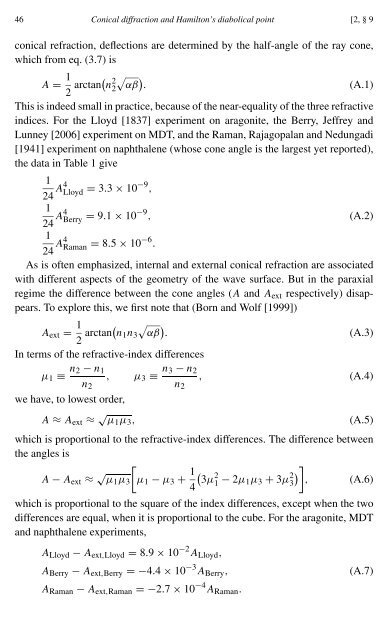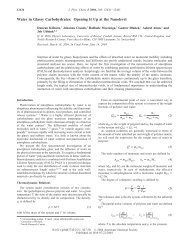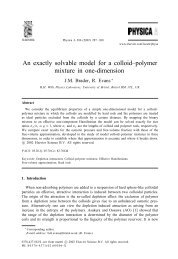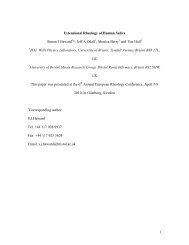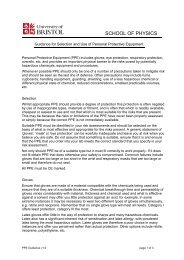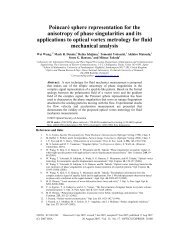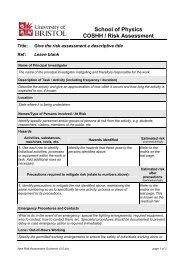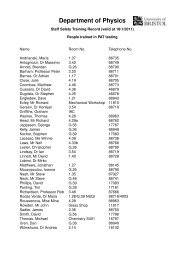Conical diffraction: Hamilton's diabolical point at the ... - Physics home
Conical diffraction: Hamilton's diabolical point at the ... - Physics home
Conical diffraction: Hamilton's diabolical point at the ... - Physics home
Create successful ePaper yourself
Turn your PDF publications into a flip-book with our unique Google optimized e-Paper software.
46 <strong>Conical</strong> <strong>diffraction</strong> and Hamilton’s <strong>diabolical</strong> <strong>point</strong> [2, § 9<br />
conical refraction, deflections are determined by <strong>the</strong> half-angle of <strong>the</strong> ray cone,<br />
which from eq. (3.7) is<br />
A = 1 2 arctan( n 2 2√<br />
αβ<br />
)<br />
.<br />
(A.1)<br />
This is indeed small in practice, because of <strong>the</strong> near-equality of <strong>the</strong> three refractive<br />
indices. For <strong>the</strong> Lloyd [1837] experiment on aragonite, <strong>the</strong> Berry, Jeffrey and<br />
Lunney [2006] experiment on MDT, and <strong>the</strong> Raman, Rajagopalan and Nedungadi<br />
[1941] experiment on naphthalene (whose cone angle is <strong>the</strong> largest yet reported),<br />
<strong>the</strong> d<strong>at</strong>a in Table 1 give<br />
1<br />
24 A4 Lloyd = 3.3 × 10−9 ,<br />
1<br />
(A.2)<br />
24 A4 Berry = 9.1 × 10−9 ,<br />
1<br />
24 A4 Raman = 8.5 × 10−6 .<br />
As is often emphasized, internal and external conical refraction are associ<strong>at</strong>ed<br />
with different aspects of <strong>the</strong> geometry of <strong>the</strong> wave surface. But in <strong>the</strong> paraxial<br />
regime <strong>the</strong> difference between <strong>the</strong> cone angles (A and A ext respectively) disappears.<br />
To explore this, we first note th<strong>at</strong> (Born and Wolf [1999])<br />
A ext = 1 2 arctan( n 1 n 3<br />
√<br />
αβ<br />
)<br />
.<br />
(A.3)<br />
In terms of <strong>the</strong> refractive-index differences<br />
μ 1 ≡ n 2 − n 1<br />
, μ 3 ≡ n 3 − n 2<br />
,<br />
n 2 n 2<br />
we have, to lowest order,<br />
A ≈ A ext ≈ √ μ 1 μ 3 ,<br />
(A.4)<br />
(A.5)<br />
which is proportional to <strong>the</strong> refractive-index differences. The difference between<br />
<strong>the</strong> angles is<br />
A − A ext ≈ √ [<br />
μ 1 μ 3 μ 1 − μ 3 + 1 3μ<br />
2<br />
(A.6)<br />
4(<br />
1 − 2μ 1 μ 3 + 3μ 2 3) ] ,<br />
which is proportional to <strong>the</strong> square of <strong>the</strong> index differences, except when <strong>the</strong> two<br />
differences are equal, when it is proportional to <strong>the</strong> cube. For <strong>the</strong> aragonite, MDT<br />
and naphthalene experiments,<br />
A Lloyd − A ext,Lloyd = 8.9 × 10 −2 A Lloyd ,<br />
A Berry − A ext,Berry =−4.4 × 10 −3 A Berry ,<br />
A Raman − A ext,Raman =−2.7 × 10 −4 A Raman .<br />
(A.7)


